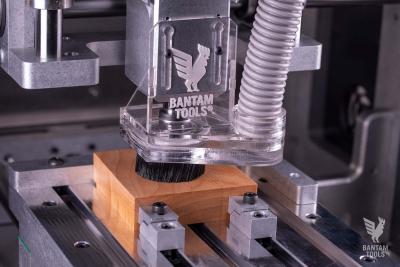
Bantam Tools is excited to announce the introduction of its new Bantam Tools Desktop CNC Vacuum Accessory. This new tool follows on the heels of Bantam Tools recent introduction of the new Bantam Tools Desktop CNC Air Blaster Accessory.
The Bantam Tools Desktop CNC Vacuum Accessory seamlessly attaches to the Bantam Tools Desktop CNC Milling Machine, allowing for live vacuuming to increase chip evacuation and decrease clean-up time. The vacuum accessory allows for better material visibility, decreased iteration time, decreased clean-up time, a smoother, better finish and helps maintain the life of end mills.
“Our customers have been requesting more accessories to go with their Bantam Tools Desktop CNC Milling Machines, and we have been hard at work creating these new accessories,” said Bre Pettis, CEO of Bantam Tools. “Last week we were excited to introduce the Bantam Tools Desktop CNC Air Blaster Accessory. This week we are introducing the Bantam Tools Desktop CNC Vacuum Accessory. Both work seamlessly to help you mill better products. We are excited to see our customers’ responses to these items and know they will encourage other mechanical engineers, entrepreneurs, electrical engineers, machinists, designers, students, educators and digital fabricators to make more parts.”
Contact Details
Related Glossary Terms
- computer numerical control ( CNC)
computer numerical control ( CNC)
Microprocessor-based controller dedicated to a machine tool that permits the creation or modification of parts. Programmed numerical control activates the machine’s servos and spindle drives and controls the various machining operations. See DNC, direct numerical control; NC, numerical control.
- gang cutting ( milling)
gang cutting ( milling)
Machining with several cutters mounted on a single arbor, generally for simultaneous cutting.
- milling
milling
Machining operation in which metal or other material is removed by applying power to a rotating cutter. In vertical milling, the cutting tool is mounted vertically on the spindle. In horizontal milling, the cutting tool is mounted horizontally, either directly on the spindle or on an arbor. Horizontal milling is further broken down into conventional milling, where the cutter rotates opposite the direction of feed, or “up” into the workpiece; and climb milling, where the cutter rotates in the direction of feed, or “down” into the workpiece. Milling operations include plane or surface milling, endmilling, facemilling, angle milling, form milling and profiling.
- milling machine ( mill)
milling machine ( mill)
Runs endmills and arbor-mounted milling cutters. Features include a head with a spindle that drives the cutters; a column, knee and table that provide motion in the three Cartesian axes; and a base that supports the components and houses the cutting-fluid pump and reservoir. The work is mounted on the table and fed into the rotating cutter or endmill to accomplish the milling steps; vertical milling machines also feed endmills into the work by means of a spindle-mounted quill. Models range from small manual machines to big bed-type and duplex mills. All take one of three basic forms: vertical, horizontal or convertible horizontal/vertical. Vertical machines may be knee-type (the table is mounted on a knee that can be elevated) or bed-type (the table is securely supported and only moves horizontally). In general, horizontal machines are bigger and more powerful, while vertical machines are lighter but more versatile and easier to set up and operate.
- milling machine ( mill)2
milling machine ( mill)
Runs endmills and arbor-mounted milling cutters. Features include a head with a spindle that drives the cutters; a column, knee and table that provide motion in the three Cartesian axes; and a base that supports the components and houses the cutting-fluid pump and reservoir. The work is mounted on the table and fed into the rotating cutter or endmill to accomplish the milling steps; vertical milling machines also feed endmills into the work by means of a spindle-mounted quill. Models range from small manual machines to big bed-type and duplex mills. All take one of three basic forms: vertical, horizontal or convertible horizontal/vertical. Vertical machines may be knee-type (the table is mounted on a knee that can be elevated) or bed-type (the table is securely supported and only moves horizontally). In general, horizontal machines are bigger and more powerful, while vertical machines are lighter but more versatile and easier to set up and operate.
